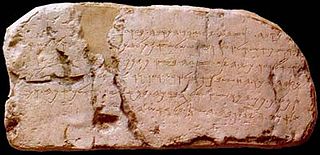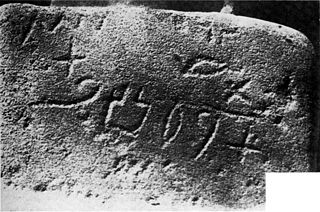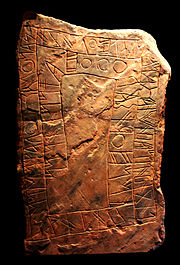
An alphabet is a standard set of letters written to represent particular sounds in a spoken language. Specifically, letters correspond to phonemes, the categories of sounds that can distinguish one word from another in a given language. Not all writing systems represent language in this way: a syllabary assigns symbols to spoken syllables, while logographies assign symbols to words, morphemes, or other semantic units.
An abjad, also abgad, is a writing system in which only consonants are represented, leaving the vowel sounds to be inferred by the reader. This contrasts with alphabets, which provide graphemes for both consonants and vowels. The term was introduced in 1990 by Peter T. Daniels. Other terms for the same concept include partial phonemic script, segmentally linear defective phonographic script, consonantary, consonant writing, and consonantal alphabet.

The ancient Aramaic alphabet was used to write the Aramaic languages spoken by ancient Aramean pre-Christian tribes throughout the Fertile Crescent. It was also adopted by other peoples as their own alphabet when empires and their subjects underwent linguistic Aramaization during a language shift for governing purposes — a precursor to Arabization centuries later — including among the Assyrians and Babylonians who permanently replaced their Akkadian language and its cuneiform script with Aramaic and its script, and among Jews, but not Samaritans, who adopted the Aramaic language as their vernacular and started using the Aramaic alphabet, which they call "Square Script", even for writing Hebrew, displacing the former Paleo-Hebrew alphabet. The modern Hebrew alphabet derives from the Aramaic alphabet, in contrast to the modern Samaritan alphabet, which derives from Paleo-Hebrew.
The Hebrew alphabet, known variously by scholars as the Ktav Ashuri, Jewish script, square script and block script, is traditionally an abjad script used in the writing of the Hebrew language and other Jewish languages, most notably Yiddish, Ladino, Judeo-Arabic, and Judeo-Persian. In modern Hebrew, vowels are increasingly introduced. It is also used informally in Israel to write Levantine Arabic, especially among Druze. It is an offshoot of the Imperial Aramaic alphabet, which flourished during the Achaemenid Empire and which itself derives from the Phoenician alphabet.

Egyptian hieroglyphs were the formal writing system used in Ancient Egypt for writing the Egyptian language. Hieroglyphs combined logographic, syllabic and alphabetic elements, with more than 100 distinct characters. Cursive hieroglyphs were used for religious literature on papyrus and wood. The later hieratic and demotic Egyptian scripts were derived from hieroglyphic writing, as was the Proto-Sinaitic script that later evolved into the Phoenician alphabet. Through the Phoenician alphabet's major child systems, the Egyptian hieroglyphic script is ancestral to the majority of scripts in modern use, most prominently the Latin and Cyrillic scripts and the Arabic script, and possibly the Brahmic family of scripts.

The Ugaritic writing system is a Cuneiform Abjad, consonantal alphabet, with syllabic elements used from around either 1400 BCE or 1300 BCE for Ugaritic, an extinct Northwest Semitic language. It was discovered in Ugarit, modern Ras Al Shamra, Syria, in 1928. It has 30 letters. Other languages, particularly Hurrian, were occasionally written in the Ugaritic script in the area around Ugarit, although not elsewhere.
Phoenician is an extinct Canaanite Semitic language originally spoken in the region surrounding the cities of Tyre and Sidon. Extensive Tyro-Sidonian trade and commercial dominance led to Phoenician becoming a lingua franca of the maritime Mediterranean during the Iron Age. The Phoenician alphabet spread to Greece during this period, where it became the source of all modern European scripts.

Biblical Hebrew, also called Classical Hebrew, is an archaic form of the Hebrew language, a language in the Canaanite branch of Semitic languages spoken by the Israelites in the area known as the Land of Israel, roughly west of the Jordan River and east of the Mediterranean Sea. The term "Hebrew" (ivrit) was not used for the language in the Hebrew Bible, which was referred to as שְֹפַת כְּנַעַן or יְהוּדִית, but the name was used in Ancient Greek and Mishnaic Hebrew texts.
Proto-Canaanite is the name given to the
The Paleo-Hebrew script, also Palaeo-Hebrew, Proto-Hebrew or Old Hebrew, is the writing system found in inscriptions of Canaanite languages from the region of Southern Canaan, also known as biblical Israel and Judah. It is considered to be the script used to record the original texts of the Hebrew Bible due to its similarity to the Samaritan script, as the Talmud stated that the Hebrew ancient script was still used by the Samaritans. The Talmud described it as the "Libona'a script", translated by some as "Lebanon script". Use of the term "Paleo-Hebrew alphabet" is due to a 1954 suggestion by Solomon Birnbaum, who argued that "[t]o apply the term Phoenician [from Northern Canaan, today's Lebanon] to the script of the Hebrews [from Southern Canaan, today's Israel-Palestine] is hardly suitable". The Paleo-Hebrew and Phoenician alphabets are two slight regional variants of the same script.
Zayin is the seventh letter of the Semitic abjads, including Phoenician zayn 𐤆, Hebrew zayīn ז, Aramaic zain 𐡆, Syriac zayn ܙ, and Arabic zāy ز. It represents the sound.
Ayin is the sixteenth letter of the Semitic scripts, including Phoenician ʿayin 𐤏, Hebrew ʿayin ע, Aramaic ʿē 𐡏, Syriac ʿē ܥ, and Arabic ʿayn ع.
He is the fifth letter of the Semitic abjads, including Phoenician hē 𐤄, Hebrew hē ה, Aramaic hē 𐡄, Syriac hē ܗ, and Arabic hāʾ ه. Its sound value is the voiceless glottal fricative.
Aleph is the first letter of the Semitic abjads, including Phoenician ʾālep 𐤀, Hebrew ʾālef א, Aramaic ʾālap 𐡀, Syriac ʾālap̄ ܐ, Arabic ʾalif ا, and North Arabian 𐪑. It also appears as South Arabian 𐩱 and Ge'ez ʾälef አ.

The Proto-Sinaitic script is a Middle Bronze Age writing system known from a small corpus of about 30-40 inscriptions and fragments from Serabit el-Khadim in the Sinai Peninsula, as well as two inscriptions from Wadi el-Hol in Middle Egypt. Together with about 20 known Proto-Canaanite inscriptions, it is also known as Early Alphabetic, i.e. the earliest trace of alphabetic writing and the common ancestor of both the Ancient South Arabian script and the Phoenician alphabet, which led to many modern alphabets including the Greek alphabet. According to common theory, Canaanites or Hyksos who spoke a Canaanite language repurposed Egyptian hieroglyphs to construct a different script.
The history of the alphabet goes back to the consonantal writing system used to write Semitic languages in the Levant during the 2nd millennium BCE. Nearly all alphabetic scripts used throughout the world today ultimately go back to this Semitic script. Its first origins can be traced back to a Proto-Sinaitic script developed in Ancient Egypt to represent the language of Semitic-speaking workers and slaves in Egypt. Unskilled in the complex hieroglyphic system used to write the Egyptian language, which required a large number of pictograms, they selected a small number of those commonly seen in their surroundings to describe the sounds, as opposed to the semantic values, of their own Canaanite language. This script was partly influenced by the older Egyptian hieratic, a cursive script related to Egyptian hieroglyphs. The Semitic alphabet became the ancestor of multiple writing systems across the Middle East, Europe, northern Africa, and Pakistan, mainly through Ancient South Arabian, Phoenician and the closely related Paleo-Hebrew alphabet, and later Aramaic and the Nabatean—derived from the Aramaic alphabet and developed into the Arabic alphabet—five closely related members of the Semitic family of scripts that were in use during the early first millennium BCE.

The history of the Greek alphabet starts with the adoption of Phoenician letter forms in the 9th–8th centuries BC during early Archaic Greece and continues to the present day. The Greek alphabet was developed during the Iron Age, centuries after the loss of Linear B, the syllabic script that was used for writing Mycenaean Greek until the Late Bronze Age collapse and Greek Dark Age. This article concentrates on the development of the alphabet before the modern codification of the standard Greek alphabet.

The Byblos script, also known as the Byblos syllabary, Pseudo-hieroglyphic script, Proto-Byblian, Proto-Byblic, or Byblic, is an undeciphered writing system, known from ten inscriptions found in Byblos, a coastal city in Lebanon. The inscriptions are engraved on bronze plates and spatulas, and carved in stone. They were excavated by Maurice Dunand, from 1928 to 1932, and published in 1945 in his monograph Byblia Grammata. The inscriptions are conventionally dated to the second millennium BC, probably between the 18th and 15th centuries BC.

The Latin script is the most widely used alphabetic writing system in the world. It is the standard script of the English language and is often referred to simply as "the alphabet" in English. It is a true alphabet which originated in the 7th century BC in Italy and has changed continually over the last 2,500 years. It has roots in the Semitic alphabet and its offshoot alphabets, the Phoenician, Greek, and Etruscan. The phonetic values of some letters changed, some letters were lost and gained, and several writing styles ("hands") developed. Two such styles, the minuscule and majuscule hands, were combined into one script with alternate forms for the lower and upper case letters. Modern uppercase letters differ only slightly from their classical counterparts, and there are few regional variants.
Biblical Hebrew orthography refers to the various systems which have been used to write the Biblical Hebrew language. Biblical Hebrew has been written in a number of different writing systems over time, and in those systems its spelling and punctuation have also undergone changes.




















